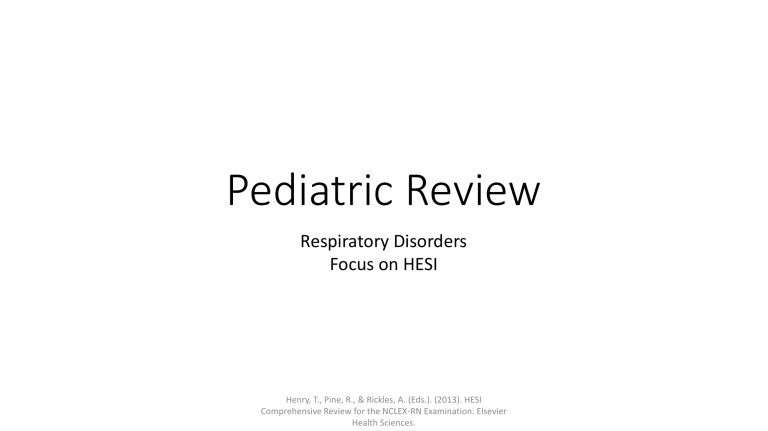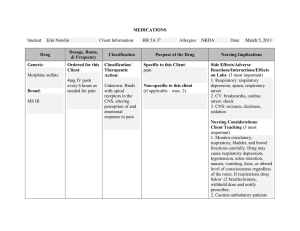
Pediatric Review Respiratory Disorders Focus on HESI Henry, T., Pine, R., & Rickles, A. (Eds.). (2013). HESI Comprehensive Review for the NCLEX-RN Examination. Elsevier Health Sciences. Signs of Respiratory Distress in Children Cardinal signs of respiratory distress • • • • Restlessness Increased respiratory rate Increased pulse rate Diaphoresis Other signs of respiratory distress • • • • • • • Flaring nostrils Retractions Grunting Adventitious breath sounds (or absent breath sounds) Use of accessory muscles, head bobbing Alterations in blood gases: decreased PO2, elevated PCO2 Cyanosis and pallor Asthma Description: Inflammatory reactive airway disease that is commonly chronic. • The airways become edematous. • The airways become congested with mucus. • The smooth muscles of the bronchi and bronchioles constrict. • Air trapping occurs in the alveoli. Asthma Nursing Assessment • History of asthma in the family • History of allergies • Home environment containing pets or other allergens • Tight cough (nonproductive cough) • Breath sounds: coarse expiratory wheezing, rales, crackles • Chest diameter enlarges (late sign and symptom) • Increased number of school days missed during past 6 months • Signs of respiratory distress Asthma Nursing Diagnoses • Impaired gas exchange related to … • Ineffective breathing pattern related to … Asthma Nursing Plans and Interventions • Monitor carefully for increasing respiratory distress • Administer rapid-acting bronchodilators and steroids for acute attacks. • Maintain hydration (oral fluids or IV). • Monitor blood gas values for signs of respiratory acidosis • Administer oxygen or nebulizer therapy as prescribed. • Monitor pulse oximetry as prescribed (usually >95% is normal). Pharmacology • Inhaled Corticosteroids • • • • • • beclomethasone dipropionate budesonide flunisolide fluticasone propionate mometasone furoate triamcinolone acetonide • Oral Corticosteroids (taken by mouth in pill or liquid form) • • • • • dexamethasone hydrocortisone methylprednisone prednisolone prednisone Pharmacology • Inhaled Long-Acting Beta-2 Agonists • Single Medication: • formoterol fumarate • salmeterol xinafoate • Combined Medication: • fluticasone propionate and salmeterol xinafoate (inhaled steroid plus long-acting beta-2 agonist) • budesonide and formoterol fumarate (inhaled steroid plus long-acting beta-2 agonist) • Epinephrine HCl (Sus-Phrine)/INH, subcutaneous, IM, IV Pharmacology • Inhaled Short-Acting Beta-2 Agonists • • • • • • albuterol Sulfate metaproterenol isoproterenol hydrochloride levalbuterol hydrochloride pirbuterol acetate terbutaline sulfate • Anticholinergics • Single Medication: • ipratropium bromide • Combined Medication: • ipratropium bromide and albuterol sulfate Pharmacology • Leukotriene Modifiers • montelukast sodium • zafirlukast • Zileuton • Oral Methylxanthines • oxytriphylline • Theophylline • Mast Cell Stabilizers • cromolyn • nedocromil • Anti-IgE • omalizumab Controller Medications Reliever Medications Inhaled corticosteroids (2) Beta2-agonists (1) (short acting) Beta2-agonists (1) (long acting) Oral corticosteroids (2) (for severe attacks) Mast cell stabilizers (2) Anticholinergics (1) (short acting) Anticholinergics (1) Leukotriene modifiers (2) 1=Bronchodilators 2=Anti-inflammatories Cystic Fibrosis Description • Autosomal-recessive disease that causes dysfunction of the exocrine glands Characterized A. Tenacious mucus production obstructs vital structures. B. Multiple problems result from the exocrine dysfunction 1. Lung insufficiency (most critical problem) 2. Pancreatic insufficiency 3. Increased loss of sodium and chloride in sweat Cystic Fibrosis Nursing Assessment 1. 2. 3. 4. 5. 6. 7. 8. Usually found in a white infant or child Meconium ileus at birth (10% to 20% of cases) Recurrent respiratory infection Pulmonary congestion Steatorrhea (excessive fat, greasy stools) Foul-smelling bulky stools Delayed growth and poor weight gain Skin that tastes salty when kissed (caused by excessive secretions from sweat glands) 9. Later: cyanosis, nail-bed clubbing, congestive heart failure (CHF) Cystic Fibrosis Analysis (Nursing Diagnoses) 1. Ineffective airway clearance related to … 2. Imbalanced nutrition: less than body requirements related to … Cystic Fibrosis Nursing Plans and Interventions 1. 2. 3. 4. Monitor respiratory status. Assess for signs of respiratory infection. Administer IV antibiotics as prescribed; manage vascular access. Administer pancreatic enzymes (Cotazym-S, Pancrease: for infants, with applesauce, rice, or cereal; for an older child, with food). 5. Administer fat-soluble vitamins (A, D, E, K) in water-soluble form. 6. Administer oxygen and nebulizer treatments (recombinant human deoxyribonuclease [DNase] or dornase alfa [Pulmozyme]) as prescribed. Cystic Fibrosis Nursing Plans and Interventions (Continued..) 7. Evaluate effectiveness of respiratory treatments. 8. Teach family percussion and postural-drainage techniques. 9. Teach dietary recommendations: high in calories, high in protein, moderate to high in fat (more calories per volume), and moderate to low in carbohydrates (to avoid an increase in CO2 drive). 10. Provide age-appropriate activities. 11. Refer family for genetic counseling. Epiglottitis Description: Severe life-threatening infection of the epiglottis Characterieistics: A. Epiglottitis progresses rapidly, causing acute airway obstruction. B. The organism usually responsible for epiglottitis is Haemophilus influenzae (H. influenzae, primarily type B). Epiglottitis Nursing Assessment 1. 2. 3. 4. 5. 6. 7. Sudden onset Restlessness High fever Sore throat, dysphagia Drooling Muffled voice Child assuming upright sitting position with chin out and tongue protruding (“tripod position”) Epiglottitis Analysis (Nursing Diagnoses) A. Ineffective breathing pattern related to … B. Anxiety related to … Epiglottitis Nursing Plans and Interventions A. B. C. D. E. F. G. Encourage prevention with Hib vaccine Maintain child in upright sitting position. Prepare for intubation or tracheostomy. Administer IV antibiotics as prescribed. Prepare for hospitalization in intensive care unit (ICU). Restrain as needed to prevent extubation. Employ measures to decrease agitation and crying. Bronchiolitis Description: Viral infection of the bronchioles that is characterized by thick secretions Characteristics A. Bronchiolitis is usually caused by respiratory syncytial virus (RSV) and is found to be readily transmitted by close contact with hospital personnel, families, and other children. B. Bronchiolitis occurs primarily in young infants. Bronchiolitis Nursing Assessment A. B. C. D. E. F. G. H. I. History of upper respiratory symptoms Irritable, distressed infant Paroxysmal coughing Poor eating Nasal congestion Nasal flaring Prolonged expiratory phase of respiration Wheezing, rales can be auscultated Deteriorating condition that is often indicated by shallow, rapid respirations Bronchiolitis Analysis (Nursing Diagnoses) A. Impaired gas exchange related to … B. Ineffective airway clearance related to … Bronchiolitis Nursing Plans and Interventions A. Isolate child (isolation of choice for RSV is contact isolation). B. Assign nurses to clients with RSV who have no responsibility for any other children (to prevent transmission of the virus). C. Monitor respiratory status; observe for hypoxia. D. Clear airway of secretions using a bulb syringe for suctioning. E. Provide care in mist tent; administer oxygen as prescribed. F. Maintain hydration (oral and IV fluids). G. Evaluate response to respiratory therapy treatments. H. Administer palivizumab (Synagis) to provide passive immunity against RSV in high-risk children 187188(younger than 2 years of age with a history of prematurity, lung disease, or congenital heart disease). Otitis Media Description: Inflammatory disorder of the middle ear Characteristics A. Otitis media may be suppurative or serous. B. Anatomic structure of the ear predisposes young child to ear infections. C. There is a risk for conductive hearing loss if untreated or incompletely treated. Otitis Media Nursing Assessment A. B. C. D. E. Fever, pain; infant may pull at ear Enlarged lymph nodes Discharge from ear (if drum is ruptured) Upper respiratory symptoms Vomiting, diarrhea Otitis Media Analysis (Nursing Diagnoses) A. Risk for infection related to … B. Acute pain related to … Otitis Media Nursing Plans and Interventions A. Administer antibiotics if prescribed. B. Reduce body temperature (can be very high, with risk for seizures). 1. Tepid baths 2. Acetaminophen (Tylenol) if prescribed C. Position child on affected side. D. Provide comfort measure: warm compress on affected ear. Otitis Media Nursing Plans and Interventions (Continued…) E. Teach home care. 1. 2. 3. 4. Teach to finish all prescribed antibiotics. Encourage follow-up visit. Monitor for hearing loss. Teach preventive care (smoking and bottle feeding when child is in supine position are predisposing factors). Tonsillitis Description: Inflammation of the tonsils Characteristics A. Tonsillitis may be viral or bacterial. B. Tonsillitis may be related to infection by a Streptococcus species. C. If related to strep, treatment is very important because of the risk for developing acute glomerulonephritis or rheumatic heart disease. Tonsillitis Nursing Assessment A. B. C. D. Sore throat and may have difficulty swallowing Fever Enlarged tonsils (may have purulent discharge on tonsils) Breathing may be obstructed (tonsils touching, called “kissing tonsils”) E. Throat culture to determine viral or bacterial cause Tonsillitis Analysis (Nursing Diagnoses) A. Impaired swallowing related to … B. Risk for injury related to … Tonsillitis Nursing Plans and Interventions A. Collect throat culture if prescribed. B. Instruct parents in home care. 1. 2. 3. 4. Encourage warm saline gargles. Provide ice chips. Administer antibiotics if prescribed. Manage fever with acetaminophen. Tonsillitis Nursing Plans and Interventions (Continued…) C. Provide surgical care if indicated. 1. Provide preoperative teaching and assessment. 2. Monitor for signs of postoperative bleeding. a. b. c. Frequent swallowing Vomiting fresh blood Clearing throat 3. Encourage soft foods and oral fluids (avoid red fluids, which mimic signs of bleeding); do not use straws. 4. Provide comfort measures: ice collar helps with pain and with vasoconstriction. 5. Teach that the highest risk for hemorrhage is during the first 24 hours and 5 to 10 days after surgery. Review of Respiratory Disorders 1. 2. 3. 4. 5. 6. 7. 8. 9. 10. Describe the purpose of bronchodilators. What are the physical assessment findings for a child with asthma? What nutritional support should be provided for a child with cystic fibrosis? Why is genetic counseling important for the family of a child with cystic fibrosis? List seven signs of respiratory distress in a pediatric client. Describe the care of a child in a mist tent. What position does a child with epiglottitis assume? Why are IV fluids important for a child with an increased respiratory rate? Children with chronic otitis media are at risk for developing what problem? What is the most common postoperative complication following a tonsillectomy? Describe the signs and symptoms of this complication. References • Henry, T., Pine, R., & Rickles, A. (Eds.). (2013). HESI Comprehensive Review for the NCLEX-RN Examination. Elsevier Health Sciences. • Hockenberry, M. J., & Wilson, D. (2012). Wong's Essentials of Pediatric Nursing: Wong's Essentials of Pediatric Nursing. Elsevier Health Sciences. • McCuistion, L. E., Kee, J. L., & Hayes, E. R. (2014). Pharmacology: A Patient-centered Nursing Process Approach. Elsevier Health Sciences.
